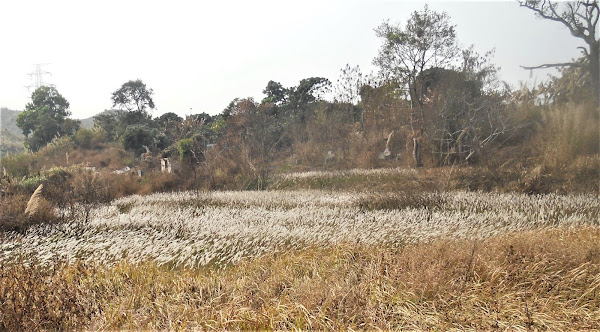Continued from Part 1.
I was walking down the path that connects Tung Kok Wai, one of five walled villages in our neighbourhood, with Sha Tau Kok Road, the only road out of Fanling to the east, when I was startled by an egret that popped up in front of me from the stream about two metres below the path on the right. Egrets are the most common large bird in Hong Kong, and this is a lesser egret, identified by its black beak:
The next photo was taken somewhere in the vicinity of Hok Tau Country Trail #2 and shows a pond heron walking casually down the path:
Grass flowers are a rarity in England, where grass is either mown, scythed down or eaten long before it has a chance to flower. However, I often see entire fields of grass flowers here in Hong Kong, as in this photo, also taken in the vicinity of Hok Tau Country Trail #2:
I can tell when the next photo was taken by its subject. Small kumquat bushes in pots are very popular at Chinese New Year, as a symbol of prosperity, and this nursery on Hok Tau Road is getting ready to ship out its latest crop:
At the start of the path from Chi Wo Road to the village of Shui Mei, there is what would once have been a shipping container with eccentric artwork on two sides. I’ll leave you, the reader, to comment on these bizarre images:
I’ve written about cotton trees before (A Blaze of Glory), but this next photo illustrates perfectly two features that are unusual for broad-leaf trees: (1) like many conifers, cotton trees have several branches from the trunk at the same height; and (2) the flowers come out before the leaves:
When we cycle upstream along the west bank of the Kam Tin River, we pass an inflatable dam on a major tributary that seems to be a popular venue for black-winged stilts. You can see why they’ve been given this name in this photo by Paula, although we will continue to refer to them simply as ‘red legs’:
It’s now March, and Paula and I have just had our first covid jab. We decided against going cycling, because we’d heard that tiredness is a common side effect, so we walked up to Lau Shui Heung Reservoir the following day instead. This photo was taken on the banks of the reservoir, and I was tempted to overprint it with the word ‘Anon’:
Close to where the last photo was taken, I noticed these strange excrescences rising from the ground. The two larger objects in the background are actually trees, and it looks as though the smaller ones will become trees, eventually:
Also in the same area is this bridge, which carries a country trail over a stream that runs into the reservoir and according to the Chinese inscription is ‘Dragon Mountain Bridge’:
Guan Gung (‘Old Man Guan’), with his fierce expression, is a popular inhabitant of wayside shrines, but why three figurines of this legendary character have been dumped in a plastic basket I cannot explain:
Nam Sang Wai Road, which runs along the bank of the lower Kam Tin River, is widely touted as ‘a good place to cycle’. It isn’t (it’s boring), and Paula concurs, but I spotted this shipping container alongside the road when we checked out this road recently:
Unlike the images on a shipping container that I included above, this one reflects what people once did for a living in this area: fishing.
A few years ago, I described a mural that I’d come across in a quiet road east of Fanling in Zoological Garden. Apart from the rooster, the rest of this artwork is now obscured by vegetation, but recently I spotted a new, and unrelated, addition:
I’ve included a view from the side because the bougainvillea obscures part of the image from the front. Notice that the flowers at the base of the mural are part of the mural, although clearly they are meant to appear as though they’re growing out of the flower bed at the bottom. The tiny red flowers are real though.
The next image is another from the Kam Tin River with quite a few egrets. The floating vegetation on the far side of the river is the result of Drainage Services Department operatives clearing large quantities of water hyacinth, which tends to clog up the river, upstream. I’m not sure why they simply allowed it to float out to sea. Laziness?
The remaining photos in this collection were taken on a walk in the Ko Po North area, east of Fanling, a few days ago. We spotted a dead tree stump adorned with bracket fungus, and we both took a photo. The first one is Paula’s:
“They’re fake!” exclaimed Paula when we spotted the subject of the next photo. But they’re not, although I’ve never seen another example of this tree, with its vicious, spiky thorns on the trunk, anywhere else:
Believe it or not, these are flowers:
previous highlights collections
Photographic Highlights: 2015–16
Photographic Highlights: 2016–17
Photographic Highlights: 2017–18
Photographic Highlights: 2018–19
Photographic Highlights: 2019–20 (Part 1)
Photographic Highlights: 2019–20 (Part 2)
Tuesday, 8 June 2021
photographic highlights 2020–21: part 2
Labels:
art,
chinese culture,
hong kong,
nature,
photography
Subscribe to:
Post Comments (Atom)






















Seeing the collection of photos surely reminds me various discovery that we had in this year!!!
ReplyDeleteSurely you haven’t forgotten already?
Delete